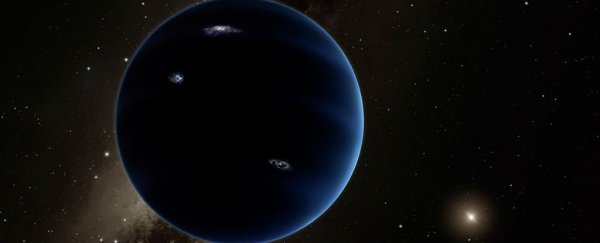Back in January, the astronomer who led the charge to have Pluto demoted to dwarf planet status announced that he'd just found evidence that a huge, icy planet could be lurking on the edge of the Solar System, just past Neptune.
Mike Brown, a planetary astronomer at Caltech University, estimated that the hypothetical 'Planet Nine' appears to be circling the Sun on a super-elongated orbit that takes an incredible 10,000 to 20,000 years to complete. And now, thanks to a newly detected Kuiper Belt Object (KBO) that's acting really strange, Brown says the case for Planet Nine just got a whole lot stronger.
"Hey Planet Nine fans, a new eccentric KBO was discovered. And it is exactly where Planet Nine says it should be," Brown tweeted over the weekend.
So what do weirdly behaving KBOs have to do with finding a never-before-seen planet in our Solar System?
Well, when you're suggesting that something as large as Planet Nine - which is estimated to be 10 times more massive than Earth and four times the size - exists within a fairly crowded patch of the Universe, you'd expect to see its considerable gravitational forces affect the smaller things floating around nearby.
And that's exactly what Brown and his colleagues have been identifying.
"We saw a strange signal in the data that meant something odd was going on in the outer Solar System," Brown told Ian Sample at The Guardian back in January. "All of these distant objects were lined up in a weird way and that shouldn't happen. We worked through the mundane explanations, but none of them worked out."
A total of six KBOs were identified as 'lining up' strangely, and now a seventh KBO has been added to the list. As Loren Grush reports for The Verge, this seventh KBO appears to have been pushed into a strange orbit by some great force nearby, about 149 billion km from the Sun, which is where Planet Nine is expected to be located. That's 75 times more distant than Pluto.
The newest object was discovered by researchers using the Canada France Hawaii Telescope to conduct the massive Outer Solar System Origins Survey (OSSOS), the latest results of which were presented recently by astronomer Michele Bannister at the SETI Institute.
Brown points to a slide showing the KBO's strange orbit from the talk as strengthening the case for Planet Nine.
Hey Planet Nine fans, a new eccentric KBO was discovered. And it is exactly where Planet Nine says it should be. pic.twitter.com/oZn0RDq8JF
— Mike Brown does not X (@plutokiller) March 24, 2016
I haven't done the statistics yet, but I suspect this takes the probability of this being a statistical fluke down to ~.001% or so.
— Mike Brown does not X (@plutokiller) March 24, 2016
Now, let's be clear about the state of Planet Nine as it currently stands. There is now strong evidence, via the strange behaviours of seven known KBOs, that something huge is lurking in the far reaches of our Solar System.
A huge planet is a good guess, but because of how incredibly distant this region in space is from Earth, we can't actually 'see' that far to visually confirm its existence. That means whatever circumstantial evidence we find for its existence needs to be incredibly solid, and we're not there yet.
Brown's yet to write up his claims that this new KBO is being influenced by a huge, nearby planet, and until they have been peer-reviewed, we have to treat them as very preliminary findings.
But more evidence - however preliminary - is exactly what Brown and other researchers need to either prove or disprove Planet Nine's existence, so this is a very exciting discovery for all involved. We can't wait to see what else they find.
